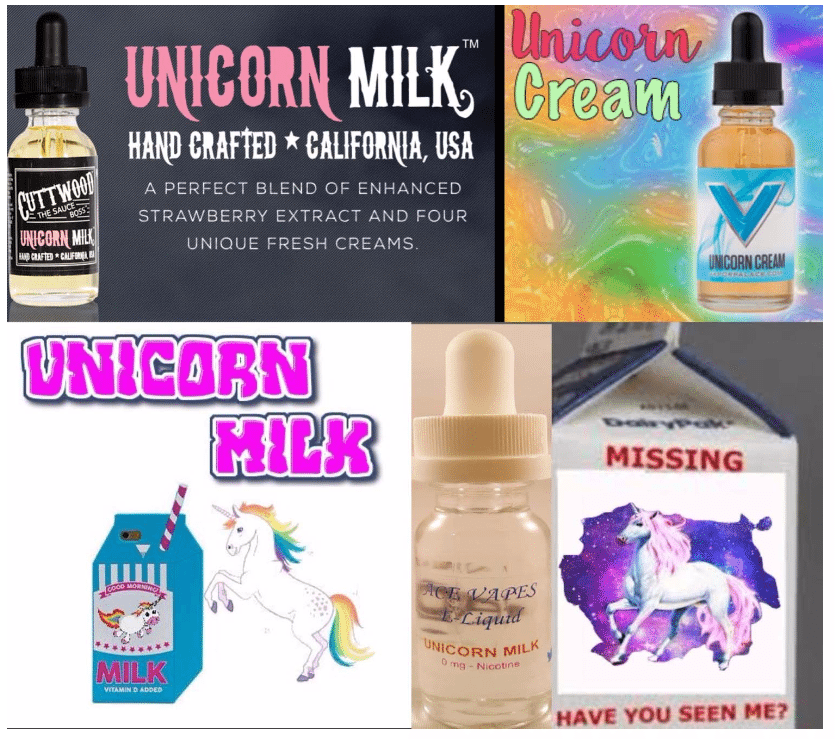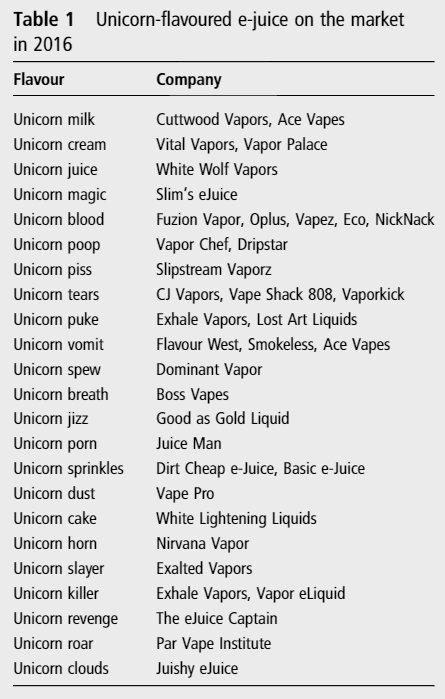New Insanity in Tobacco Control

Every once in a while there is such utter ridiculousness that I simply cannot help but laugh. See, this is one of many reasons why I (like Dick Puddlecote) love ecigs. They have managed to throw the entire tobacco control industry into such frothing madness it is pure comedy. These budding researchers - seeking to make a name for themselves within the tobacco control industry - are analysing everything to do with ecigs in a bid to make the mantra “ecigs are bad mmmkay” more legitimate. As in, let’s make the ridiculous stance of the FDA, Australia and the EU the right one by doing untold amounts of utterly pointless trash that will later get cited by more ridiculous trash to make these nasty horrible ecigs go away.
Well, this one has not only scraped the bottom of the tobacco control research barrel, it’s broken through and dug a rather large hole on the other side.
Unicorns cartoons: marketing sweet and creamy e-juice to youth
Yes. That is the title of this paper. A five-page research study into unicorns. Specifically, these researchers are “extremely concerned” about the prevalence of the humble unicorn on e-juice that they believe that the sheer number of e-juice with the word “unicorn” or the image of a unicorn is solely responsible for the “dramatic rise in teen ecig use”.

Because unicorns are popular in children’s literature, the purpose of this five-page opus is to describe unicorn themed flavoured e-juice and their associated advertising messaging. So what exactly did they do?
Well, unsurprisingly for the journal Tobacco Control there’s very little substance. An introduction, some results and the discussion. No methodology present.
In analysing over 12 000 e-cigarette advertisements, we have encountered a remarkable assortment of unicorn-themed e-juice products
Quick! Hide! Unicorns are taking over! Have you even such utterly crass fuckwittery?

Of course, the fact that e-juice is an adult product doesn’t seem to enter the pea sized brains of these researchers. Especially since regulations are being passed (have passed in the case of the EU) regarding age restricted sale - as if that made the blindest bit of difference with tobacco - and the fact that the majority of reputable vendors won’t sell to teens this “research” should have been stopped at review. But of course it wasn’t, ‘cos its ecigs ya see. Oh, and do pay attention to the table where these researchers show just how clueless they are by calling them “Unicorn-flavoured” e-liquids.
Discussion
This is where the fun really starts.
Unicorn-themed e-cigarette advertisements are prime examples of the type of youth appealing marketing which are contributing to the rapid rise in teen use. Potential grounds for regulating unicorn-themed e-cigarette advertising include both their use of youth-oriented flavours and use of cartoons.
See, it’s never been about health has it? These researchers are “so concerned” about the use of unicorns on e-juice they think that anything ecig related with a unicorn on should be regulated. Quite bonkers.
The 2009 Family Smoking Prevention and Tobacco Control Act banned any artificial or natural characterising flavour additive, other than tobacco or menthol, from traditional combustible cigarettes.
Just a bit wistful that isn’t it? Flavours have been banned in tobacco, but we’ve missed a trick with e-juice. Madness.
The appeal of whimsical cartoon characters to youthful consumers, typified by Joe Camel, is widely acknowledged. In 1998, as part of the Master Settlement Agreement the tobacco industry agreed to discontinue use of cartoon characters in tobacco marketing based on their attractiveness to youth.
Oh my, would you just think of The Children™! See, they’ve been very successful in getting governments to do their bidding on tobacco - based purely on junk science - that they aim to do it all over again with more junk science.
Since 1976, commercial speech has been subject to first amendment protection from government regulation. This clearly complicates governmental regulation of advertising text and imagery, raising the possibility that new regulations placed on e-cigarette advertising could be ruled non-constitutional.
Aha! A glimpse of sanity. See, in the US commercial speech (as they term it) is subject to the First Amendment, which as they rightly point out complicates regulation significantly. They also think that by applying stricter marketing rules on ecigs could very well breach the US Constitution. Remind me, isn’t one of the lawsuits against the FDA including that very sentiment?
Of note, cartoon figures have also been used in anti-smoking campaigns to good effect. Turning the marketers’ toolkit around, in 2015 the American Legacy Foundation’s Truth Campaign included a ‘puking unicorn’ in their video to warn youth about the dangers of smoking.
But of course, it is absolutely fine and dandy when they do it.
The proliferation of sweet and creamy unicorn-themed e-juice is but one of many youth appealing practices employed by e-cigarette companies in the absence of regulatory boundaries. Were the e-cigarette industry to be subject to regulations constraining youth marketing, unicorns in the e-cigarette world would once again become as rare as unicorns are supposed to be.
Aren’t they just so cute?
As with most science emerging from the US it’s never really been about discovering how to make ecigs better, but rather how can they regulate them out of existence under the pretext of “public health”.
(image credit Catmando/shutterstock.com)